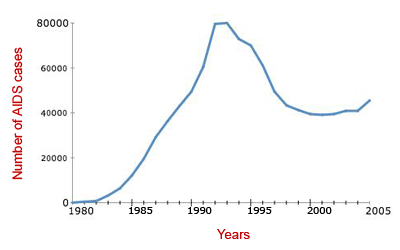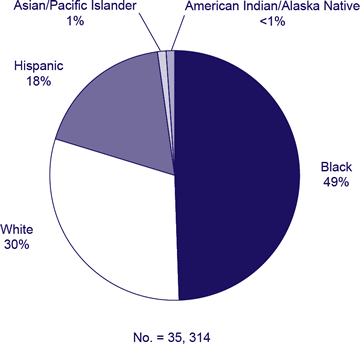Introduction
“Epidemics are like signposts from which the statesman of stature can read that a disturbance has occurred in the development of his nation–that not even careless politics can overlook.”-Dr. Rudolf Virchow, 1848 (Paul R. Epstein, n.p.)
The first country in the world to discover HIV is the United States of America. This epidemic disease was come to the front in 1981, with its disastrous effects and spread. From 1981 till 2005 it has been spreading tremendously that now over half a million people have been affected and died from this disease in America. The current research showed that still there are one million people spending live with this horrible disease and a number of people among them are unaware of the infection growing up in their bodies which can be more disastrous for normal people if these infected people get married and have partners. (Bonita de Boer, n.p.).

How HIV is affecting the inner cities and suburban in America?
This disease in the US affects all parts, places, and sort of people, no matter rich or poor, men or women, even children inheriting it from their parents, black or white, etc. At the beginning of its spread, the most generally affected people were from the sort of group; drug injectors, hemophiliacs and Haitians, etc. With the passage of time HIV is being a serious problem and is spreading vastly between gays, bisexual men, heterosexual African Americans, and Latinos. (Bonita de Boer, n.p).
The disease is not only growing according to different groups and their characteristics but also with regard to geographical locations and areas. HIV was earlier considered in the US as a disease among gays majority on the eastern and western coast but now it has been influenced the Black and Latinos living on the southern coasts. (Bonita de Boer, n.p). The darkest side of this disease is that its affected person is extremely demoralized and humiliated socially. People try to stay away from them, look down upon them and isolate them from social gatherings and even daily matters. This is what has been observed in even large cities in the US.
How HIV is affecting the blacks, whites, and Hispanic communities?
In the US the blacks are nine times more affected by HIV than whites. Although if we take a look at the population proportion of Africans in America its just 13% but on the other hand if we consider the AIDS population almost 39% of the effects since 2001 are blacks. Generally, HIV infection in blacks starts from sexual contact. The 2003 report showed that 75% of men and 22% of black women were suffering from this disease due to heterosexual contact, while 47% of men were reported for being infected through men-to-men relations and 22%-23% of men, as well as women, were suffering from the disease due to drug injections. The spread of HIV in blacks is not only limited to civilians but also it is widely found in prisoners. Research reveals that at the end of 2003 nearly 700,000 people were residing in adult jails in the US. (Kim M. Blankenship, PhD, Amy B. Smoyer, MSW, MPA, Sarah J. Bray, JD, and Kristin Mattocks, Ph.D., n.p.)
HIV infection is equally found in black women residing in the US. The recent statistics, which was revealed in 2007 showed that 27% of the HIV cases came to the front, were of black women, however in 2003 28% of women HIV cases were reported and the majority of the affected were non-Hispanic black group women. Moving ahead to the year 2004 statistics showed that the HIV infected were blacks, 10 times more than whites and three times more than Hispanics. (HIV and Black Women, n.p.)
After taking a peer review on how and with what percentage HIV is affecting blacks and Hispanics in the US let us find out, what are its impacts on whites and Central Americans. To the Latino/Hispanic community, the most worrying menace is HIV and is the fourth major cause of people in this area. ( Center for disease control and protection, n.p.)

Based on data from 33 states with long-term, confidential name-based HIV reporting. (Center for disease control and protection, n.p.)
What can our society do to change the growing number of HIV affect ed?
HIV-affected people in any country, belonging to any region or religion face the same problems. Such people are treated very badly in society. No one thinks about the facts on how to tackle such a situation in a harmonious way when you come to know that you are having an HIV-infected person living in your neighbors or at the workplace. Society can play a vital role in minimizing the growing number of AIDS effects in the US or any other region in the world. This can be done through many ways like an awareness program, a bit of motivation, proper treatment on time hospitalization, etc. In the US some schools are providing education about sex which encapsulates information about HIV and awareness at a young age as a compulsory subject so that when the children leave school they are fully aware of the problems and after-effects. (Bonita de Boer, n.p.)
Recently in the US abstinence-only education was introduced, whose motive was to aware children to wait to have sex until before they get married, this education program and other such can be very useful to buildup a child’s character to be a sensible man or woman in society and to live HIV free life. HIV awareness program at the adults’ level is much important. This can be done through discussions. These discussions can be at the workplace, social gatherings, seminars, workshops, etc they can be very much helpful and result-oriented so that they must know their life can be in danger. Advanced and proper treatment systems are an important factor in the campaign and awareness in the fight against HIV. If society needs a change to cut down the growing trend then the authorities concerned must have to take proper action with regard to medicine and cure of this epidemic disease. Fortunately, the US being a developed state spent a lot on this issue, every year a large sum of money is granted for the cure, provision of medicine, and awareness programs from the poorest to average civilians. (Bonita de Boer, n.p.).
Whenever any poll or view is taken from the general public it is often observed that the response is full of old myths and false perceptions. The NGOs can contribute in organizing lectures, at schools, colleges, and universities as well as workplaces to make eradicate false concepts. Collectively, teachers, NGOs, Government authorities, and everyone make up society and in some way or other can play his/her role. (Bonita de Boer, n.p.)
Conclusion
The birthplace of the disease HIV can be any but the Americans first discovered it. The history of this hazardous disease is not too old but since its advent, it has been spreading with a tremendous speed. Every year a great number of people become its victim and many die. In the US alone there are a million people who suffer from this disease, and they belong to different religions, ethnicities, and cultures. In a country like the US where everything is so fast and up-to-date till the last decade, we observe old myths and fear in people about the disease, but fortunately, the awareness programs introduced by the Government and private NGOs have contributed a lot. At present, the view has changed a bit. People have started thinking differently, which is a vital aspect of humanity.
No matter these people are suffering from contagious diseases but still they are human beings and they have the right to live their remaining lives normally and peacefully. Once this disease was regarded as only gay or heterosexual men/women disease but in today’s era it is not limited or specified, every year a new record has been added, and old vanishes leaving the affected people to death. Among the different ethnicities residing in the US, the largest affected group is African and more specifically African women. Even after a drastic change in technology, medicine, and all other fields one cannot say that HIV is not a problem. It is a problem and the war against it will be continued till it is resolved!!
Works Cited
Bonita de Boer,(n.p). Web.
Kim M. Blankenship, PhD, Amy B. Smoyer, MSW, MPA, Sarah J. Bray, JD, and Kristin Mattocks, PhD, Black-White Disparities in HIV/AIDS: The Role of Drug Policy and the Corrections System, (n.p.). Web.
HIV & Black Women, (n.p.). Web.
Center for disease control and protection, (n.p.). Web.